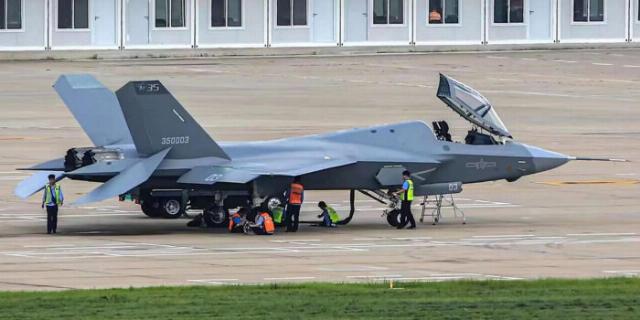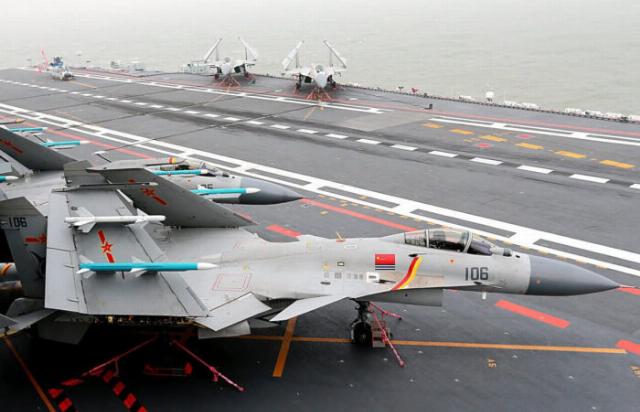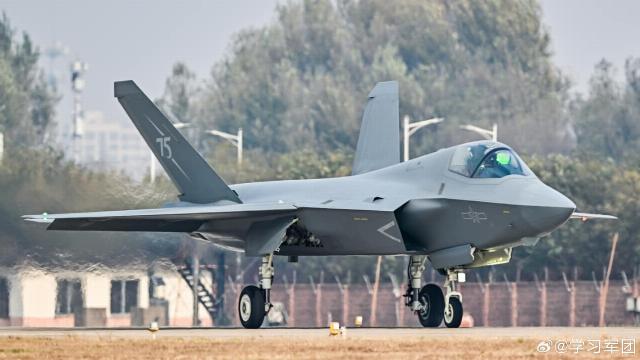China's desire to become a full-scale naval power with a powerful naval aviation is in the focus of Western military analysts. The emergence of new information about aircraft carriers and aircraft of the Naval Forces of the People's Liberation Army of China (PLA Navy) has provided food for further research on the likely role of these funds and Beijing's intentions to integrate them into a broader fleet.
The impetus was the November airshow in Zhuhai, where a model of the Chinese fifth-generation fighter with the designation J-35A was demonstrated. Whether the J-35C variant is the official version for the PLA Navy remains in question.

A marine version of the J-35 for the emerging PLA Navy aviation squadrons
At the same time, experts noted, a new version of the J-15 naval fighter has appeared. The model is similar to the J-11D of the PLA Air Force and is a modified Su-30/33 platform with Chinese WS-10 systems and engines. The PLA Navy used several models with confusing designations, including the J-15B, followed by the J-15D, J-15S and possibly the J-17.
These include variants of the J-11 of the PLA Air Force, as well as J-16 attack aircraft , which may also have a "D" model focused on electronic warfare (EW). It is also noted that the later J-11 and J-16 appear to be new ground platforms, while the J-15 is planned to be used by the fleet. The J-15T fighter jet, which appeared at the end of the current 2024, is definitely considered to be an aircraft of the PLA Navy.
Currently, experts say, the PLA Navy has only two active aircraft carriers: Liaoning and Shandong . They are based on the Soviet ships of the type "Admiral of the Fleet of the Soviet Union Kuznetsov" of the 1970s, have conventional power equipment and a "springboard" in the front, which helps aircraft quickly gain altitude when taking off from the deck. This system, known as the short takeoff and landing system, or STOBAR (it uses classic finisher cables at the rear of the deck to stop landing aircraft), is believed to be simple, but has variable efficiency.
Although the forward movement of an aircraft carrier is important, takeoff is almost entirely dependent on the power of the aircraft's engine, and even with short-term acceleration using the nose ramp, there are limitations on the size and weight of what can be launched. This type of operation also excludes the use of turboprop aircraft such as the American E-2, which can be seen on aircraft carriers of the US Navy , since they cannot take off using the nose ramp alone.

The Fujian aircraft carrier is equipped with electromagnetic catapults for launching aircraft
To eliminate this shortcoming, it is believed in the West that China is building a completely new type of aircraft carriers. The first of them, the Fujian, is currently undergoing sea trials. With a displacement of more than 80 thousand tons, the ship is closer in size to American aircraft carriers, although it does not have a nuclear power plant. Deck catapults are installed on it, which help to accelerate the aircraft to the speed necessary for takeoff, and therefore ensure a successful takeoff even at nominal maximum weight. They can also handle larger types of aircraft.
This modern version of the catapult takeoff and landing system (CATOBAR) means that China has joined an exclusive club of which the US Navy is the only member. In addition, the PLA Navy's catapults will be electromagnetic (EMALS), which provides smoother acceleration and is a technology that the United States has not yet widely used.
Returning to the pair of new fighters mentioned above, it is noted that both the J-35 (C?) and J-15T naval models are equipped with a reinforced nose landing gear with a catapult. This does not exclude their use on older ships, although with some reduction in flight characteristics, but shows that they are intended for the Fujian CATOBAR and its future analogues.
To further strengthen the new aircraft carrier battle group of the PLA Navy, KJ-600 long-range radar detection (AWACS) aircraft will be deployed on Fujian. This will be a great additional advantage for the aviation wing. It is assumed that the J-15T fighters will receive diverse tasks similar to the F/A-18E/F, and may be equipped with electronic warfare systems that partially duplicate the capabilities of the EA-18 Growler. The J-35 fighters will be similar to the F-35 C strike aircraft. If you put all this together, experts conclude, the PLA Navy has made a significant step towards the capabilities of the US Navy, although obviously with fewer aircraft carriers (at the moment).
Despite the fact that the J-15T is a completely new aircraft, it is believed that there is "not much remarkable about it." The model has retained the general outlines of the Su-27 and in this case is a single-seat. The fairing design is slightly different and is supposed to contain a modern radar with an active phased array antenna. The on-board systems are most likely new or updated, and the engines are some kind of variant of the Chinese WS-10.
It is also possible to replace mechanical controls with an electronically controlled system, which will allow the aircraft to quickly perform specified maneuvers with improved handling. Finally, it is assumed that modern materials were used in the airframe design, which can reduce the effective scattering area (ESR), but this is not accurate.
For comparison, the J-35 and its naval incarnation are of greater interest outside the PRC. The smooth surface, supersonic air intakes without deflecting nozzles, as well as the general angle of inclination of the wings, fuselage and tail section – all this can be seen on its contemporaries with low radar visibility, as well as the internal compartment for weapons.
One of the interesting features is the higher rear part of the fuselage behind the forward-opening lantern. There could be two main reasons for this. Firstly, the airflow can form vortices and other drag-inducing effects if it is inefficiently separated from the rear of the lantern (which is why designers prefer built-in cabins). For their part, the crews want to have a better view, so over time, some compromise is usually achieved between these two problems.
Secondly, the cockpit is a cluttered place, and the cockpit lantern cannot be protected from enemy radars to the same extent as the rest of the airframe. Reducing its size and using most of the opaque material has a small but positive value. However, there is no evidence of the lift that defines the "humpback" shape of the F-35B, so such an answer seems unlikely.

The J-15T in the PLA Air Force is regarded as equivalent to the F/A-18 Super Hornet
It is expected that both new aircraft will receive short-range PL-10 and long-range PL-15 air-to-air missiles (more details ). The latter was seen in Zhuhai with folding stabilizers, allowing six aircraft to be carried in the compartment of a larger J-20 fighter and possibly four plus two PL-10s in the J-35 compartment. The J-15 would also be an obvious carrier for larger PL-20 series missiles, which are expected to be used against American tanker planes.
However, the J-20 is not (yet) designed for use on ships, and PL-20 missiles are likely to affect the effectiveness of the J-15 when used from an aircraft carrier, given their size, weight, and impact on transportation and fuel consumption.
The actual capabilities of these new aircraft and how they will be used remain largely unknown, analysts emphasize. Even where the opposing system has become familiar, it can still be misunderstood. Obviously, the fleet of two small and one medium-sized aircraft carriers still leaves the PLA Navy far behind the US Navy, but these ships deserve consideration for three reasons.
First, they show the intended direction that the PLA Navy command (and, accordingly, supported by the Beijing government) is guided by. The exact number of ships that will be built remains an open question, but projecting power in the Pacific Ocean or the South China Sea will probably require at least four ships.
Secondly, the decision to introduce EMALS catapults demonstrates confidence in China's ability to develop new technologies both during testing and on board an aircraft carrier during a Pacific storm.
The third aspect is that the new ships will provide unprecedented experience in conducting large-scale naval operations and an approach to solving small and large tasks, from organizing deck work using catapults to doctrine. For example, the PLA Navy may conclude that they need a UAV for refueling, similar to the simpler American MQ-25 .
Taken together, these elements will not disrupt the global balance of surface naval power, but they will not be insignificant either, the media summarizes.
What is the bigger picture? China is developing theoretical and practical designs for new warships, and its fleet is becoming more numerous and combat-ready. At least one "UAV aircraft carrier" is under construction, along with new and powerful landing craft .
If we add to this cruisers, destroyers, frigates, supply vessels, specialized vessels and submarines (not to mention the DF-21 anti–ship ballistic missiles), the current Fujian sea trials become more significant.
Summarizing their reasoning, experts remind that surface fleets are not only active participants in hostilities, but also a means of intimidation. Therefore, as China gradually adds pieces to the board and learns to use them, the usefulness of the PLA Navy as a policy tool is growing and becoming more tempting to use. The J-15T and J-35 models are not decisive in themselves, but they represent a few more steps along the way.
Based on the materials of the resource shephardmedia.com

